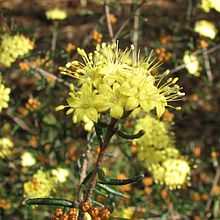Phebalium stenophyllum
| Narrow-leafed Phebalium | |
|---|---|
 | |
| Scientific classification | |
| Kingdom: | Plantae |
| (unranked): | Angiosperms |
| (unranked): | Eudicots |
| (unranked): | Rosids |
| Order: | Sapindales |
| Family: | Rutaceae |
| Genus: | Phebalium |
| Species: | P. stenophyllum |
| Binomial name | |
| Phebalium stenophyllum (Benth.) Maiden & Betche | |
| Synonyms | |
| |
Phebalium stenophyllum, commonly known as Narrow-leafed Phebalium, is a shrub which is endemic to Victoria and New South Wales in Australia. It grows to between 1 and 1.5 metres in height and produces clusters of starry yellow flowers in the spring.[1] The species was first formally described as a variety of Phebalium squamulosum by George Bentham in Flora Australiensis in 1863. The type specimen was collected by botanist Ferdinand von Mueller in "the Grampian Mountains and desert of the Tattiara country towards the Murray river".
It was subsequently published as a species in its own right by Joseph Maiden and Ernst Betche in A Census of New South Wales Plants in 1916. [2]
The presence of the species in South Australia is uncertain.[3]
Cultivation
Phebalium stenophyllum is cultivated as an ornamental flowering shrub. The species has some frost tolerance and performs best in a well-drained, partially shaded position. Established plants can withstand dry periods.[4]
References
- ↑ "Phebalium stenophyllum". PlantNET - New South Wales Flora Online. Retrieved 2007-09-12.
- ↑ "Phebalium stenophyllum (Benth.) Maiden & Betche". Australian Plant Name Index (APNI), IBIS database. Centre for Plant Biodiversity Research, Australian Government.
- ↑ "Census of South Australian Vascular Plants". Retrieved 17 August 2011.
- ↑ Greig, D. (1987). The Australian Gardener's Wildflower Catalogue. Australia: Angus & Robertson. ISBN 0207154600.